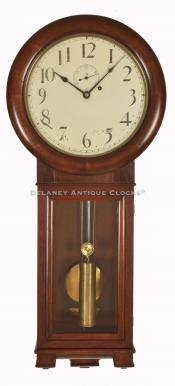Seth Thomas Regulator No. 2. This mahogany case example was ordered by the US Goverment. 221225.
The Seth Thomas Model Number 2 has always been a very popular clock. This model was first made in the 1860s and enjoyed a production run of over 100 years. Over this period, the Number 2 experienced a small number of design changes. These included slightly redesigning the movement and the case's base moldings. As a result, clock enthusiasts are able to date many of these clocks within a range of 20 years. This fine example was made sometime around 1900. It was marketed as a small regulator for railroads, schools, fire departments, offices, etc.
Finding an example of a Number 2 in a wood other than oak can be challenging. This case is constructed in mahogany and retains a historic finish enhanced with wax. The deep brown color is excellent. The dial bezel and the lower rectangular door are fitted with glass. Looking through the lower door, one can view the side-to-side motion of the pendulum and, over time, the lowering of the weight. The Clockmaker's label can be found pasted to the bottom board inside the case.
The No 2 model built a solid reputation on the reliability of its performance. The weight-driven movement is of good quality. (Please note that it was photographed before servicing.) It features well-finished rectangular-shaped brass plates, a Graham deadbeat escapement, and maintaining power. The front plate is die-stamped with the letter "U." This letter signifies that the US Goverment used this clock. The movement is designed to beat eighty beats per minute and run for eight days between winding. The works are secured to a large iron mounting bracket, which is attached to the backboard. This mounting bracket also supports the pendulum. The pendulum is constructed with a wooden rod that supports a large brass-faced zinc bob. This swings behind the brass-covered cylindrical weight.
The clock dial is original to this clock and is painted on zinc. It measures approximately 12 inches in diameter and is in good condition. It does have a small number of areas that have experienced some losses.
This fine example measures approximately 36.5 inches long overall, 16 inches wide, and 5.75 inches deep. It was made circa 1890.
Inventory number 221225.












